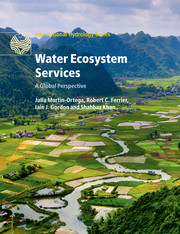Book contents
- Frontmatter
- Contents
- List of contributors
- Preface
- 1 Introduction
- 2 What defines ecosystem services-based approaches?
- Part I Addressing global challenges
- Part II Applying frameworks for water management and biodiversity conservation under an ecosystem services-based approach
- Part III Assessing water ecosystem services
- Part IV Broadening the perspective
- Index
- Plate Section
- References
2 - What defines ecosystem services-based approaches?
Published online by Cambridge University Press: 05 May 2015
- Frontmatter
- Contents
- List of contributors
- Preface
- 1 Introduction
- 2 What defines ecosystem services-based approaches?
- Part I Addressing global challenges
- Part II Applying frameworks for water management and biodiversity conservation under an ecosystem services-based approach
- Part III Assessing water ecosystem services
- Part IV Broadening the perspective
- Index
- Plate Section
- References
Summary
2.1 INTRODUCTION
It has long been held that human life depends on the existence of a finite natural resource base, and that nature contributes to the fulfilment of human needs (Malthus 1888; Meadows et al. 1972). This knowledge has led to different and evolving ways of understanding the relationship between humans and nature (Raymond et al. 2013). The notion of ecosystem services is one of these, which began to be developed in the late 1960s (King 1966; Helliwell 1969; Study of Critical Environmental Problems 1970; Odum and Odum 1972). How human needs and well-being interact with quantities and qualities of the finite natural resource base, and how changes to the natural environment impact on human activities and vice versa, are key questions underlying the conceptual development of ecosystem services and related concepts.
In 2000, the Secretary-General of the United Nations called for a worldwide initiative, the Millennium Ecosystem Assessment, ‘to assess the consequences of ecosystem change for human wellbeing and the scientific basis for action needed to enhance the conservation and sustainable use of those systems’ (Millennium Ecosystem Assessment 2003). Ecosystem services were defined as ‘the benefits that people obtain from ecosystems’ and the Millennium Ecosystem Assessment emphasised the need to incorporate the value of ecosystem services into decision-making to reverse increasing degradation of ecosystems. Since the publication of the Millennium Ecosystem Assessment in 2005, economic approaches to the understanding and management of natural resources based on the notion of ecosystem services have been increasingly discussed in the scientific literature (Fisher et al. 2009; Norgaard 2010; Ojea et al. 2012). The Millennium Ecosystem Assessment was followed by a number of other initiatives to assess ecosystem services, the most significant global assessment being The Economics of Ecosystem Services and Biodiversity (Kumar 2010). Other national-level assessments, for example, the UK National Ecosystem Assessment (2011; see Schaafsma et al., this book) and the Spanish Millennium Ecosystem Assessment (EME 2011) have also been published.
Information
- Type
- Chapter
- Information
- Water Ecosystem ServicesA Global Perspective, pp. 3 - 14Publisher: Cambridge University PressPrint publication year: 2015
References
Accessibility standard: Unknown
Why this information is here
This section outlines the accessibility features of this content - including support for screen readers, full keyboard navigation and high-contrast display options. This may not be relevant for you.Accessibility Information
- 8
- Cited by
